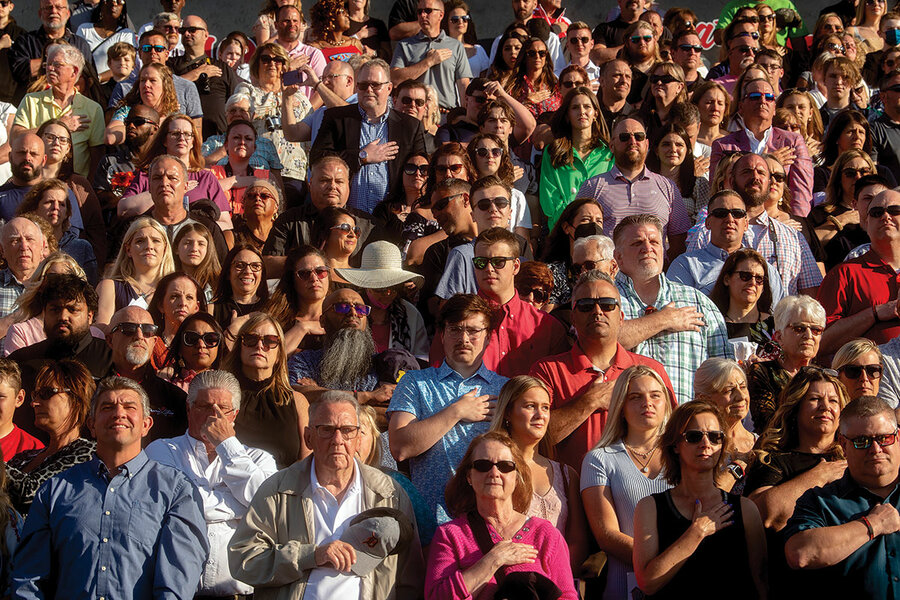‘Star-Spangled Banner’: How its meaning changes with each generation
Loading...
The national anthem of the United States is full of surprises, writes Mark Clague, a professor of musicology at the University of Michigan, in “O Say Can You Hear?: A Cultural Biography of ‘The Star-Spangled Banner.’”
Nearly everything about the 208-year-old anthem – from its meaning to how people sing it – has changed over time. Like America itself, the song is always evolving, Professor Clague tells the Monitor. The interview has been lightly edited and condensed.
You point out that the first line is a question, not a declaration. Can you explain?
Why We Wrote This
America’s national anthem has served evolving roles, from bolstering unity to celebrating freedom. A musicologist says it inspires ideas “about what America is, and what it could be.”
We don’t realize that the “O say does that star-spangled banner yet wave / O’er the land of the free and the home of the brave?” ends with a question mark, not an exclamation point. The song asks: Is the country still free? Is the flag still there?
It’s a question that gets renewed with every performance and constantly refreshes and changes depending on what’s going on. The song really highlights the notion of freedom and whether we have the courage as a country to try to live up to this ideal.
What’s in the verses that most of us don’t sing?
The first verse asks: “Is the flag still there, is the country going to survive?” The second verse says “Yes, it’s still here. The British said they’d defeat us, where did they go?” The third verse mocks the British enemy as arrogant vassals and failed mercenaries, in contrast to the brave, free, just, and victorious Americans. The fourth verse [imagines] a country that’s unified by religion.
The very pious Francis Scott Key … felt that the nation was weak militarily, politically divided, and moving toward a dangerous secularism. For him, the unexpected American victory against a superior British force in Baltimore was nothing short of divine intervention. He calls America the “Heav’n rescued land” and calls upon Americans to “Praise the Power [God] that has made and preserved us a nation!”
Why don’t we sing these verses?
The short answer is time. We have made the ritual last longer: We sing the anthem at a slower tempo today than would have been the case in Key’s day. An upbeat song of victory has become a solemn hymn of national devotion.
What do you make of protesters who take a knee during sporting events?
In a way, the anthem started as a protest song because it created a vision of a united future that didn’t exist in 1814. For me, calling the country to account and calling Americans to live up to our ideals is really a function of the song, and it doesn’t disrespect it to call attention to where the country falls short.
The song is famously difficult to sing. What makes it such a challenge?
It’s entirely the [vocal] range required: The distance between the lowest and highest notes is unusually wide.
The melody comes from a song sung at a musician’s club in England and was intended to be a rousing, challenging tune that really highlighted the skills of club members. Often it was sung by a professional actor, someone equivalent to a Broadway singer today.
The song does require a heroic commitment. Part of why “The Star Spangled Banner” became the national anthem is because it’s rousing, it’s motivating, and it’s energizing in a way that, say, “America the Beautiful” is not.
My big tip for anybody trying to sing the song, particularly by themselves, is that you have to start low, as low in your range as possible, with the “O Say Can You See” part, so that you’re still comfortable when you get to the high notes.
What’s the most influential performance of the song?
Whitney Houston’s at the 1991 Super Bowl.
“The Star Spangled Banner” started out as a kind of waltzing, lilting, upbeat victory song. But when you hear her sing it, with a beat added to every measure so the verses last longer, it’s a sacred hymn to the nation. It’s actually pretty unusual, but it feels traditional because the performance comes from the heart and feels sincere, affirming, and absolutely true.
What’s your favorite performance?
Jimi Hendrix at Woodstock. The combined message of patriotism and protest is fascinating. He played the anthem 70 or more times, not just at Woodstock, and every single performance is different. He would stick in other melodic references like TV jingles to show what was going on in the country in any given moment. Sometimes the performances are really patriotic, and other times they’re dystopian and dark, like at Woodstock when he ends with “Taps.”
What should people think about when they sing the anthem?
They’re part of a conversation about the United States that has been going on since 1814. Since the song was written, it has become a way of reflecting and inspiring ideas on what America is and should be. People should see themselves as part of that history but also making their own personal statement to advance the conversation.






